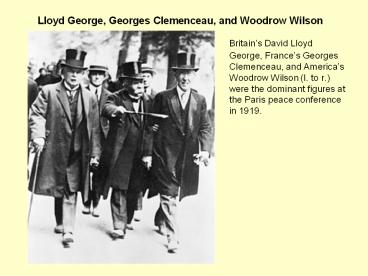Lloyd George, Georges Clemenceau, and Woodrow Wilson - PowerPoint PPT Presentation
1 / 9
Title:
Lloyd George, Georges Clemenceau, and Woodrow Wilson
Description:
Gandhi with spinning wheel ... In 1920 Mohandas 'Mahatma' Gandhi (1869-1948) launched a national campaign of ... Indian politics, and Gandhi made Congress into ... – PowerPoint PPT presentation
Number of Views:585
Avg rating:3.0/5.0
Title: Lloyd George, Georges Clemenceau, and Woodrow Wilson
1
Lloyd George, Georges Clemenceau, and Woodrow
Wilson
- Britains David Lloyd George, Frances Georges
Clemenceau, and Americas Woodrow Wilson (l. to
r.) were the dominant figures at the Paris peace
conference in 1919.
2
World War I Peace Settlement in Europe and the
Middle East
- The map of central and eastern Europe, as well
as that of the Middle East, underwent drastic
revision after World War I. The enormous
territorial losses suffered by Germany,
Austria-Hungary, the Ottoman Empire, Bulgaria,
and Russia produced gains for France, Italy,
Greece, and Romania and the appearance or
reappearance of at least eight more independent
states. The mandate system for former Ottoman
territories outside Turkey proper laid
foundations for several new, mostly Arab, states
in the Middle East.
3
Germanys Western Frontier
- The French-Belgian-German border area between
the two world wars was sensitive. Despite efforts
to restrain tensions, there were persistent
difficulties related to the Ruhr, Rhineland,
Saar, and Eupen-Malmédy regions that
necessitated strong defenses.
4
"N'Oublions Jamais" This 1915 French poster with
its passionate headline--Never Forget!--dramatizes
Germany's brutal invasion of Belgium in 1914.
Neutral Belgium is personified as a traumatized
mother, assaulted and ravished by savage outlaws.
The "rape of Belgium" featured prominently, and
effectively, in anti-German propaganda.
5
Palestinian Arabs protest In the early twentieth
century, Great Britain and France had agreed to
divide up the Arab lands at Versailles President
Wilson had insisted that the right of
self-determination should be applied to the
conquered Ottoman territories. To present their
view to the Americans, Arab nationalists passed a
resolution on July 2, 1919 that called for
political independence, and talked of possible
French rule under a League of Nations mandate and
the establishment of a Jewish national home. This
wasn't the view of all Arabs. In this photo,
Palestinian Arabs protest against large-scale
Jewish migration into Palestine.
6
"No Home Rule" poster, 1914 Posters like this
one--No Home Rule--helped to foment pro-British,
anti-Catholic sentiment in the northern Irish
counties of Ulster before World War I. The rifle
raised defiantly and the accompanying rhyme are a
thinly veiled threat of armed rebellion and civil
war. (National Museums of Northern Ireland)
7
Opening of Suez Canal, 1869
Opening of Suez Canal, 1869 This colored
engraving depicts the opening of the Suez Canal,
which the French had built across Egyptian
territory in 1869, linking the Mediterranean to
the Red Sea and the Indian Ocean. It
significantly shortened the voyage by ship from
Europe to East Asia. The Suez Canal exemplified
the speeding up of transportation and
communication in the second half of the
nineteenth century.
8
Gandhi with spinning wheel Mohandas "Mahatma"
Gandhi (1869-1948) believed that foreign cotton
mills had impoverished the Indian people. He made
a bonfire of imported factory-made cloth, decided
to wear only handmade cloth, and began spending
half an hour every day spinning yarn on a simple
spinning wheel, which became the symbol of his
movement. Any Indian who wished to come before
him had to dress in handwoven cloth.
9
"The Right Path to Liberty" In 1920 Mohandas
"Mahatma" Gandhi (1869-1948) launched a national
campaign of nonviolent resistance to British rule
in India. The result was nothing less than a
revolution in Indian politics, and Gandhi made
Congress into a mass political party with members
from every ethnic group. This Indian National
Congress poster--The Right Path to Liberty--draws
upon Indian culture to build support for
nationalism. All Indian communities are marching
toward freedom, but Gandhi, Jawaharlal Nehru
(1889-1964), and others are in prison, and a
bridge has collapsed. Yet the Hindu deity Krishna
reassures anxious Mother India with a little
more sacrifice the journey will be complete.































